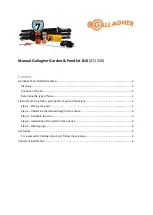
Compressor
A
Compressor
is used to increase sustain, tighten up the guitar signal, and prevent the signal
from clipping the input of other effects. It sets a maximum boundary (Threshold) for the
strength of a signal. If a signal exceeds the Threshold, it is squeezed back into compliance
based upon the compression Ratio setting.
Comp On/Off -
The
Number 1 Knob
turns the Compressor on (
ON
) and off (
OF
).
Attack -
The
Number 2 Knob
adjusts the length of time it takes for the Compressor to
respond to a signal exceeding the Threshold. Values include:
fast
,
meDIUM
, and
slOw
.
Ratio -
The
Number 3 Knob
adjusts the input to output ratio once the Threshold has been
exceeded. For instance, a Ratio of 4 to1 means that a signal exceeding the Threshold
by 4 dB will only be allowed 1 dB of increased output. Ranges include:
1.2-1
(1.2 to
1),
1.5-1
(1.5 to 1),
1.8-1
(1.8 to 1),
2.0-1
(2 to 1),
2.5-1
(2.5 to 1),
3.0-1
(3
to 1),
4.0-1
(4 to1),
5.0-1
(5 to 1),
8.0-1
(8 to 1),
10-1
(10 to 1),
20-1
(20 to
1), and
00-1
(infinity to 1).
Threshold -
The
Number 4 Knob
adjusts the maximum strength the signal is allowed to
reach before the compressor begins to work. Ranges from
1
to
99
.
Gain -
The
Number 5 Knob
adjusts the Output Gain from the Compressor. Ranges from
0
to
6
(dB).
Amp Modeling/Cab
Amp Modeling
is a technology which applies the tone of one of several vintage or modern
amps to your guitar signal. The RP300A’s Amp Modeling also provides an acoustic guitar
simulation. The Amp Modeling section includes an A and a B channel. Each channel can be
individually programmed to include different settings for Amp Gain, Amp Level, Cabinet Type,
Mic Position, and EQ. This allows you to switch from a clean to a distorted setting while
retaining all other Effects settings. Switching Amp channels is accomplished instantly with the
Amp A/B Footswitch
.
The
Cabinet Modeling
simulates different types of miked speaker cabinets. You have your
choice of 6 Cabinet Types and 4 Mic Placements in relationship to each speaker cabinet.
Amp Channel -
The
Number 1 Knob
selects the
A
or
B
channel. You may also use the
A/B Footswitch
to select the amp channel during the editing process.
Amp Type -
The
Number 2 Knob
selects one of the Amp Models or Acoustic Simulator.
Choices include:
Marshall® is a registered trademark of Marshall Amplification Plc. Vox® is a registered trademark of Korg UK. Fender,
Matchless, and Mesa Boogie, are trademarks of their respective companies and are in no way associated with DigiTech.
Amp Gain -
The
Number 3 Knob
adjusts the Gain (distortion) for the selected Amp
Model (not available for Acoustic). The Gain parameter ranges from
0
to
99
.
Amp Level -
The
Number 4 Knob
adjusts the Level (volume) of the selected Amp Model.
The Level parameter ranges from
1
to
99
.
Cabinet-Mic -
The
Number 5 Knob
selects the type of simulated Speaker cabinet as well
as mic placement in relation to the speaker. Your choices include:
DIRECT
- Turns the modeling off
BLKFAC
- Based on a ‘65 Fender Twin Reverb
BOUTIQ
- Based on a Matchless DC30
RECTIF
- Based on a Mesa Dual Rectifier
HOTROD
- Based on a Mesa Boogie Mark II C
tweeD
- Based on a ‘57 Fender Tweed Deluxe
CLEAN1
- Based on a Vox AC30 top boost
CLEAN2
- A clean tube combo setting
STACK
- Based on a Marshall JCM900
CRUNCH
- A nice crunchy combo
HIGAIN
- Based on a Johnson JM150 High Gain
FUZZ
- A vintage fuzz distortion
ACOUST
- A flat top acoustic guitar
11
Summary of Contents for Artist RP300A
Page 1: ...User s Guide...














































